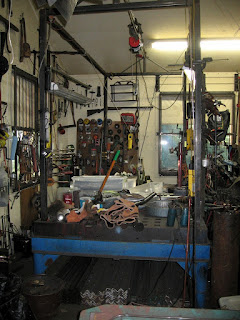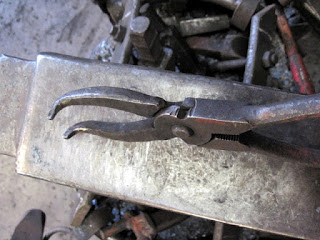The large blacksmith bellows is found with a number of variations which is as expected with a tool developed over a rather long time period by many craftsmen over a wide geographical area.
The dual chamber configuration, which is my subject here, helps top provide a continuous air stream through the tuyere into the fire pot. The chambers can be in tandem as illustrated in this Viking style setup. http://warehamforgeblog.blogspot.com/2008/07/aristotle-furnace-demonstration.html or, on a larger scale, they can be hooked up to a huge water wheel as at Hopewell Furnace as illustrated on this blog http://www.cr.nps.gov/nr/twhp/wwwlps/lessons/97hopewell/97visual1.htm
In the most commonly seen small shop design the chambers are stacked. In the bellows which I restored the top and bottom chambers were probably equal sized. It consisted of a bottom (intake) leaf with two circular holes with interior flapper valves, a center (passthrough) leaf with a single circular hole and flapper valve, a solid top panel and two rib panels plus the tuyere and a little bit of other iron hardware for mounting and lifting.
I have heard of designs with two ribs in the upper chamber which opens wider that the lower chamber but have never seen one.
The leaves are laminated light clear hardwood boards of various widths. As I recall there is no tongue and groove or spline reinforcing in mine and they rely on a couple of transverse boards to keep the panels flat and sturdy. This is similar to how a Z door would be made without the angled racking board. Some fancy forging as in large staghorn hinges could dress up at least the top leaf which is the most visible part.
Construction weight might be a consideration when moving or mounting but doesn’t matter much when in operation as the lever arm physics aren’t complicated. Adjusting the fulcrum and length of the lifting lever for comfortable use should be relatively easy.
These antique tools were made in the days before dimensional lumber standardization so board thickness can also vary a lot from specimen to specimen as can the variety of wood and other features. The center leaf panel may be thicker than the top and bottom leaves as it must accommodate the half axles which suspend the tool and also capture the bottom half of the proximal end of the tuyere.
I decided to sketch a set of plans as if I were making a new bellows with modern equipment while trying to preserve some traditional appearance. I’m going to use the approximate measurements from my bellows model to make a set of drawings while realizing that scaling up or down might be useful to fit a particular situation. Mine is just 4’ long and I’ve seen them up to about 6’ and heard of them even longer.
The first major change I would make would be in the center leaf. It is the spine of the bellows body and sturdiness can provide longevity. In addition, it is not visible. I’d make the center leaf a laminated construction from three pieces of 1/2” thick plywood. By dividing the inner board into nose and tail segments at the widest point and separated by a 1/2” (strong) gap an axle space is created for passing a 1/2” round rod all the way across. This insures integral support and alignment.
Using a composite design would also allow relatively easy cutting out of material in the nose end to fit the tuyere.
The top leaf is the least complicated but most visible one. I would take some care to make it look traditional with clear pine panels glued up with yellow wood glue. I’d probably use a biscuit jointer technique which wouldn’t be visible.
In the bottom leaf I would follow the advice of others who have suggested making the air intake area greater that the area the air passes through in the center panel. It would cut three 5” diameter holes in the bottom while the center would have two 5” holes all fitted with flapper valves. A tail extension can extend the lever arm for lifting. My bellows doesn’t have that feature.
I have seen some designs in which the leather or leather substitute skin attached as a single piece. I suppose it could be made in one, two, three or four pieces. I made mine with four independent leathers and I think that would make repair of a malfunctioning valve easier. Which would be about the only reason to get inside the body after the bellows is completed. Which reminds me that I would add some screening to the bottom holes to block out the wasps and I’d plug the tuyere when not in use.
A satisfactory leather pattern can be drawn by propping up a couple of leaves to approximate the opening angle and using something like a tacked up strip of freezer paper and a pencil to trace the outline of the space. This low tech approach may reflect my Ozark upbringing. Neatsfoot oil helps keep the leather soft and flexible. I got out my copy of Alex Bealer’s book and read the section in chapter 3 about the bellows construction and operation. He states that a good bellows has enough leather to allowing opening to a width which equals or is greater than the widest part of the bellows. Mine will open well in excess of his formula so my leather panels are probably larger than necessary.
After one experience with a minor blow back explosion in the bellows I fitted mine with a ping pong ball valve to prevent volatile gas back flow. Usually this wasn’t a problem but on a particularly gusty day at a demonstration the wind occasionally dammed up in the forge hood cavity and pushed the gas in the fire pot back into the tuyere and caused a low pitch explosion. It was easy to imagine how that could damage the bellows skin.
The flapper valves need to be light weight with a really flexible hinge and seal fairly well. The potential for a slapping noise on closure is a consideration as well as preventing a valve from getting stuck open. Adding some fabric to prevent wood on wood noise will work. I used thin soft leather for my hinge material and attached another narrow strip to the non-hinged side to limit the opening arc to about 45º so the valve could never flip over and get stuck open.
The tuyere can be fabricated from 14 gauge steel sheet and the nose collar can be made from something like 1.8” x 2” flat bar or even a strip of sheet.
The nose block is built around the nose of the center leaf. After it is laminated it is carved to relieve the outer edges and fit the collar which keeps the wood snug around the tuyere. Today I’d probably spend less time on accurate carving and just hog out the space and the secure a perfect inside fit of the tuyere with GREAT STUFF or something similar where it wouldn’t be seen but would provide a tight air seal. http://greatstuff.dow.com/products/
Several years ago I made top and bottom leaves but never got any further. Maybe I should take them to a blacksmithing meeting as see if I come across someone interested in going on with the project.
http://www.persimmonforge.com/

































